ShelfLife Tasting: Argentina still offers value
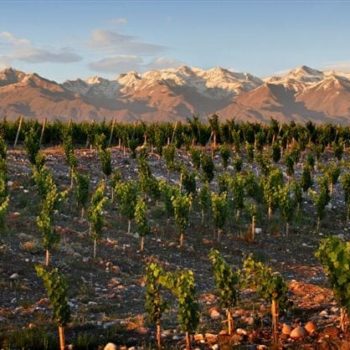
Argentina's financial meltdown and following turbulence caused difficulties for the wine industry, increasing costs of wine. Below, ShelfLife highlights wine bottles at World Malbec Day that were of particular interest
15 June 2018
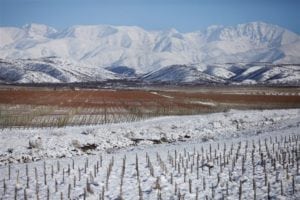
Winters in Argentina’s vineyards can be surprisingly chilly
Argentina is in trouble again. Some years ago, its economy thoroughly overheated and, partly fuelled by the pegging of its Peso to the US dollar, it went into financial meltdown. Millions lost their savings and the middle classes were hit hard. Thanks to careful financial management by President Nestor Kirchner and a boom in commodities, the country managed to crawl its way back to stability by 2007.
Mr Kirchner’s wife succeeded him and eventually put Argentina back on the road to ruin, by vastly increasing public spending and nationalising companies. Inflation soared to 40%, the black market flourished and investors began to flee. For the wine industry, it was a very difficult time as input costs rose but wine prices could not always rise to match.
Ms Kirchner has been succeeded by the more restrained President Macri. Capital controls have ended and public spending has been cut back. Unfortunately, part of his policy was to issue quick-maturing bonds at a very high interest rate. Recently, investors have begun to lose confidence in Macri’s ability to redeem these bonds – which are really just a form of high-interest national debt – and an air of crisis has returned. At the moment, Argentina’s government has been talking with the IMF in the hope of getting financial support to repay bonds and gradually return to stability.
For the wine trade, the turbulence has further increased costs, with suppliers demanding payment upfront before the final wine can be sold. There is also a shortage of funds for investment in wineries and for marketing. Entry point wines will always find buyers in markets such as Ireland and the UK but quality wine has been a much harder sell. Producers have been unable to create a distinctive profile for their finer producing regions and wines. Its share of the Irish market remains small at under 3%.
It’s a shame, because while a lot of Argentina’s entry point wines are workaday, bottles at €13-€18 often over-deliver on price. World Malbec Day remains the prime marketing push for Argentina on the Irish market, although it has long extended the day’s tastings into the sampling for virtually all its grapes. The recent Dublin event was smaller than during the boomier years but there was plenty of interesting wine at fair prices to consumers. There was lots of malbec, of course, but it was worth keeping eyes peeled for decent cabernets, shiraz and whites. Here’s some of what was on offer; with the entry bottles so familiar to consumers, we’ve highlighted some of the better stuff. Prices are retail approximates.
Reds
 Luigi Bosca Signature Malbec 2015 (Barry & Fitzwilliam, €15). A smoothly maturing red, good for game and beef.
Luigi Bosca Signature Malbec 2015 (Barry & Fitzwilliam, €15). A smoothly maturing red, good for game and beef.
Dona Paula Estate Cabernet Sauvignon 2016 (Gilbeys, €12). Warm berry and blackcurrant fruit, this is great with roast lamb.
Finca Sophenia 2 Malbec Cabernet Sauvignon 2015 (Nicholson, €16.50). Malbec can be a slightly heavy grape and the addition of the fresher cabernet generally works nicely in improving the balance. This is an elegant wine and a great companion for roast beef.
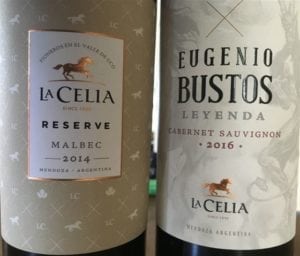
Cabernet and Malbec from the La Cella estate in Argentina’s Mendoza. The Malbec is from the Uco sub-region which gives it some fresh cooler climate elements (Imported by BWG)
Trapiche Reserve Pinot Noir 2016 (Comans, €12). Great value pinot with tasty summer fruits. Would go well with cold meats and salads.
Alta Vista Premium Estate 2016 (Mitchells, €14). Decent plum and berry fruits make this perfect for duck and lamb.
Barrancas Mendoza Malbec 2017 (Liberty, €15). A glug of the Italian grape ancellotta is added here to increase freshness. Lively fruits make this good for drinking on its own or even with an unadorned steak or chop.
Kaiken Obertura Cabernet Franc 2015 (Liberty, €30). Both Chile and Argentina produce some fine cabernet franc; the pity is that there is so little of it. This one is enjoyable, with elegant fruit and decent finish. It’s a treat wine but there are cheaper cabernet francs around (occasionally!) and almost all are worth a try.
Fabre Montayou Reservado Cabernet Franc 2015 (Whelehans Loughlinstown, €11). While Whelehans is a relative newcomer to the Irish distribution scene, it is run by David Whelehan, who cut his teeth at O’Briens and is an experienced hand at the wine game. This is a tasty red with a slightly crisp edge. Would work well with duck.
Andeluna Malbec 2016 (Celtic Whiskey, €16). Velvety red fruits with a ripe edge.
Callia Blend Malbec 2016 (Mackenway, €15). Ripe, plummy flavours with a hint of spice. Good for barbecues.
Whites
Callia Alta Pinot Grigio 2017 (Mackenway, €15). There’s a lot of routine pinot grigio around but this is a tad above. Ripe apple and grape flavours make it a lovely summer wine.
Masi Passo Bianco 2016 (Findlater, €15). This includes 10% torrontes, a slightly spicy white grape. It’s lively stuff, with a slightly white flower edge to both nose and palate. Great with salads and vegetarian dishes.
Domaine Bousquet Chardonnay 2017 (Tindal, €16). Zesty citrus flavours with pleasant refreshing finish. Lovely with cold chicken and fish. There’s a pricier grand reserve version which would make a fine gift wine.
Andeluna Torrontes 2017 (Celtic Whiskey, €15). The highly aromatic torrontes was once trumpeted as Argentina’s signature white – until a lot of us discovered that its chardonnay and pinot grigio was often better. It’s not a bad variety, though, so long as growers don’t let its floral elements get out of hand. This is an appealing one, ideal as a summer aperitif or with starters.
Salta Torrontes Colome Torrontes 2017 (Liberty, €20). And if you fancy learning a bit more about well-handled torrontes, you could treat yourself to this. Grown at almost 2,000 metres about sea level, aromas are elegant, with tasty, very slightly floral fruits, nicely laced with citrus and herbal notes. Perfect with Thai or Chinese food.



 Print
Print
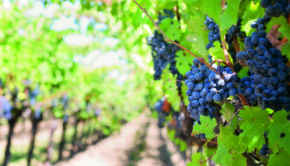
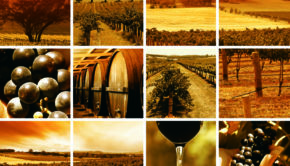


Fans 0
Followers